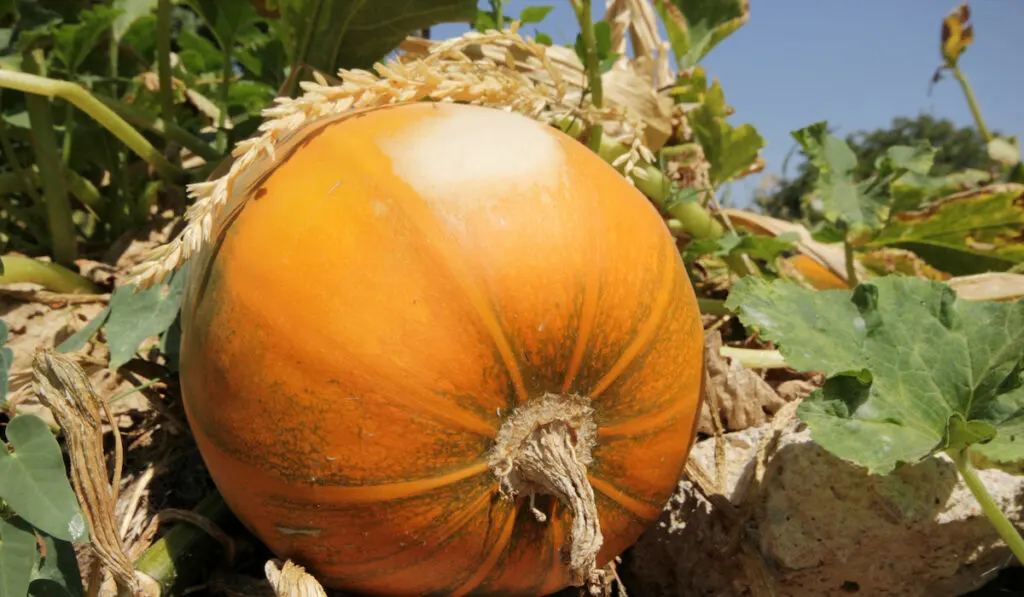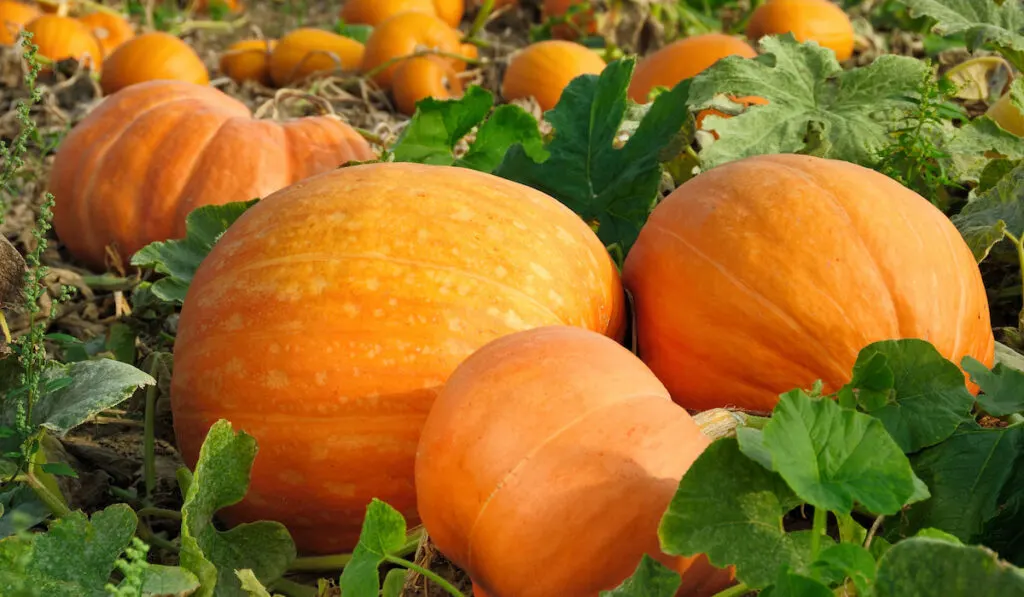Whether you’re a home gardener or a farmer, knowing how to determine the perfect planting time for pumpkins is crucial. Pumpkins require a long growing season of about 75 to 100 frost-free days. This calls for good timing to get a bumper pumpkin harvest.
Can a pumpkin grow in hot weather?
Pumpkins can grow in hot weather provided they get plenty of water as they are warm-season crops. You should plant them once the soil temperature reaches 70 degrees Fahrenheit or more. If the temperature is too hot, you will need to provide shade for the leaves so that they don’t wilt and die.
Here is some information to help you get the most out of your pumpkin harvest.

Table of Contents
How Hot Is Too Hot for Pumpkins?
Pumpkins thrive at a temperature of 50 to 90 degrees Fahrenheit. Even though some varieties can tolerate heat, they may not bear fruits when temperatures are consistently above 90 degrees Fahrenheit. Pumpkins will die when exposed to extreme heat, wet weather, cold, pests, and diseases.
The best way to figure out the perfect time to plant pumpkins is by keeping track of weather patterns in your area. If you’re able, observe when pumpkins begin blooming in your garden so you have a better idea of what the average first frost date for your region will be.
How To Determine The Perfect Planting Time for Pumpkins
Pumpkins are very sensitive to cold, and thus if you are ready to plant your pumpkins, wait until after your last frost date to ensure safety from colder temperatures.
If you plant pumpkin seeds in cold soil they will rot or fail to germinate.
Pumpkins grow best with at least six hours of sunlight a day. You should plant them after all danger of frost has passed and soil temperatures are 65°F or higher. Most pumpkins mature 80 to 130 days, and planting them early May to mid-June will ensure you have a bumper harvest.
For pumpkins that are faster maturing, you can plant them in July or August, and you will have pumpkins by Halloween.
Seed packets show the time it will take for the pumpkins to mature.
Bees are essential agents of pollination, and they don’t fly until chilly spring weather is gone. If your pumpkin vine produces flowers before this time, pumpkins will not blossom or mature. Once temperatures fall into the 30s, pumpkins stop growing and stop producing fruit.
Planting pumpkin seeds in the cold ground will result in the seedlings getting injured by frost.

Can Pumpkin Plants Survive Extreme Heat?
The large pumpkin leaves help shield the soil from direct sun and help keep the roots cool. However, when the heat is extreme, the soil dries out, and the vines start to drop flowers and any developing fruit, and the plant eventually dies. To keep your plants from wilting and eventually dying out, you should regularly water them.
Ensure your pumpkin plant gets 1 to 1.5 inches of water per week. This will be sufficient enough to keep your plant alive in the summer heat.
Water your pumpkin slowly and deeply at the base of the plant but not on the leaves.
Wetting the pumpkin leaves may cause fungal diseases to the plant. The best way to irrigate is by using the drip irrigation method.
How Long Do Pumpkins Last in The Heat?
After the pumpkin has matured, you need to remove it from the vine and store it in a place with an ideal temperature. For a pumpkin to last longer, they need to be away from extreme heat and direct sun.
Direct sunlight speeds up the rotting process, and to properly store your pumpkin, temperatures between 50° and 60°F are ideal.
Before harvesting, you can shade the pumpkin to shield it from direct sunlight that may cause it to rot. The lifespan of a pumpkin depends on whether or not you cut them. An uncut pumpkin can last up to three months if you keep it away from extreme heat.
You can follow these tips if you want your pumpkin to stay longer:
- Let the pumpkin dry off by itself on the vine and shake off the excess dirt.
- Keep it in a cool, dry, well-ventilated place like a basement, garage, or barn. This will preserve its shape and prevent it from having a shrunken appearance.
- If the pumpkin gets moist, use an old towel to wipe off any moisture and let it sit for one day.
If you store your harvested pumpkins in a suitable storage area with a temperature of 50-55°F and relative humidity of 50-70%, they will retain their good quality for 2-3 months.

The Best Weather to Grow Your Pumpkin
Pumpkins are more weather-sensitive than other plants. They are heat-loving plants and when planting, make sure the soil is warm enough. Still, water is essential, but too much rain will cause your pumpkin to rot, while dry weather will lead to smaller and lighter pumpkins.
There are different varieties of pumpkins that you can plant depending on the weather condition in your area:
- Cucurbita maxima
- Cucurbita pepo
- Cucurbita moschata
Cucurbita pepo and Cucurbita maxima varieties can be stored for more extended periods. The best time to plant them is when the daytime temperatures are 60°F or above.
The Cucurbita moschata are more heat tolerant varieties compared to maxima and pepo varieties. You can plant this variety on rich, loose soil in late spring or early summer.
When to Plant Pumpkins in Different Parts of the U.S.
Here is when to plant pumpkins in some parts of the U.S:
- Southern California – End of May or early June
- Florida – Late March to early April *If you happen to plant your seeds late, you will likely get smaller pumpkin fruits that will likely be prone to fungal diseases and viruses.*
- Texas – June first and July first
- Arizona – August

4 Tips for Keeping Pumpkins Cool in Hot Weather
1. Give shade
In hot weather, you can protect your pumpkins from drying out by keeping them in shady areas. Some varieties do better in the heat than other varieties, so pay attention to how your plants are doing.
2. Protect them from rain/moisture
Moisture will cause your pumpkins to rot, so when you protect your pumpkins from the hot sun, you should also protect them from rain or water to prevent mold and mush.
3. Water your pumpkins
Water your pumpkins regularly to enable your pumpkin to grow a healthy root system. Slowly water the base of your plant while avoiding the vine, the leaves, and the pumpkin. You can use drip irrigation to prevent the soil from being eroded.
4. Keep away from direct sunlight
Once you pluck the pumpkins from their vines, you need to keep them away from direct sunlight. Store your pumpkins in a cool, dry area with plenty of ventilation.
Final Thoughts
To ensure you get a bumper pumpkin harvest, whether for the Halloween season, making pumpkin pies, competition, or selling, you need to prepare the soil and plant early enough before summer begins.
The ground should have enough water to facilitate the growth of the pumpkins.
Dry soil is not suitable for pumpkin growth, and thus, you have to water the soil, preferably using drip irrigation. Be careful not to wet the vine or the leaves as this may cause the plant to rot.
The soil temperature should be warm for the pumpkin to sprout and grow. Enough sun will keep the leaves healthy. These leaves will provide shade to the pumpkin and provide moisture to the pumpkins.
Sources:
- https://www.pumpkinnook.com/howto/protect
- https://harvesttotable.com/how_to_grow_pumpkin
- https://colors-newyork.com/what-temperature-is-too-hot-for-pumpkins
- https://extension.psu.edu/pumpkin-production
- https://www.npr.org/sections/thesalt/how-long-does-a-pumpkin-last
- https://www.gardenzeus.com/growing-halloween-pumpkins-in-hot-summer-california-areas
